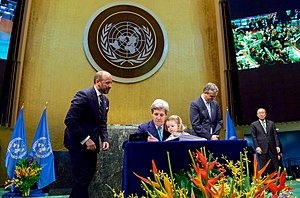Translations:Paris Agreement/22/en
Signing and entry into force
The Paris Agreement was open for signature by states and regional economic integration organizations that are parties to the UNFCCC (the convention) from 22 April 2016 to 21 April 2017 at the UN Headquarters in New York. Signing of the agreement is the first step towards ratification, but it is possible to accede to the agreement without signing. It binds parties to not act in contravention of the goal of the treaty. On 1 April 2016, the United States and China, which represent almost 40% of global emissions confirmed they would sign the Paris Climate Agreement. The agreement was signed by 175 parties (174 states and the European Union) on the first day it was opened for signature. As of March 2021, 194 states and the European Union have signed the agreement.

The agreement would enter into force (and thus become fully effective) if 55 countries that produce at least 55% of the world's greenhouse gas emissions (according to a list produced in 2015) ratify or otherwise join the treaty. Alternative ways to join the treaty are acceptance, approval or accession. The first two are typically used when a head of state is not necessary to bind a country to a treaty, whereas the latter typically happens when a country joins a treaty already in force. After ratification by the European Union, the agreement obtained enough parties to enter into effect on 4 November 2016.